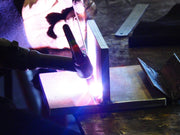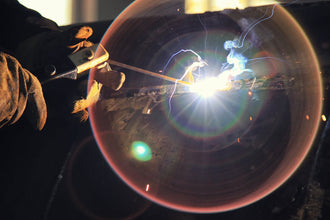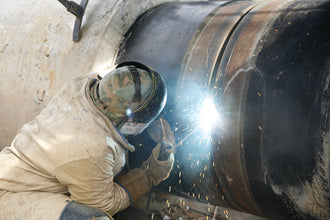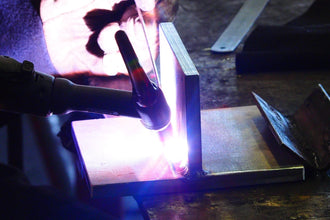
In the world of metal fabrication and welding, TIG AC/DC welding stands out as a versatile and precise method for achieving professional-grade results. Whether you're a seasoned welder or a DIY enthusiast, understanding the benefits of using a TIG AC/DC welder can transform your approach to welding. This comprehensive guide explores the science, applications, and advantages of TIG welding with AC/DC capabilities.
1. What Is TIG AC/DC Welding?
1.1. The Basics of TIG Welding
TIG (Tungsten Inert Gas) welding, also known as GTAW (Gas Tungsten Arc Welding), uses a non-consumable tungsten electrode to produce a weld. Unlike MIG or stick welding, TIG requires a steady hand and offers unparalleled control over the weld pool. The process relies on an inert shielding gas, typically argon or helium, to protect the weld area from atmospheric contamination.
2.1. AC vs. DC in TIG Welding
The terms AC (Alternating Current) and DC (Direct Current) refer to the polarity of the electrical current used in welding:
DC TIG Welding: Direct current flows in one direction, ideal for welding steel, stainless steel, and titanium.
AC TIG Welding: Alternating current switches direction, making it perfect for welding aluminum and magnesium.
A TIG AC/DC welder combines both polarities, allowing welders to tackle a broader range of materials and projects.
2. Key Advantages of Using a TIG AC/DC Welder
2.1. Unmatched Versatility
A TIG AC/DC welding machine lets you switch between AC and DC modes, making it suitable for:
Aluminum and Magnesium (AC mode): AC breaks through oxide layers on softer metals.
Steel, Stainless Steel, and Titanium (DC mode): DC provides deeper penetration and cleaner welds.
This versatility eliminates the need for multiple welding machines, saving time and money.
2.2. Superior Weld Quality
TIG welding with AC/DC produces:
Cleaner Beads: Minimal spatter and slag.
Precision Control: Adjust amperage and frequency for thin or thick materials.
Stronger Joints: Ideal for critical applications like aerospace or automotive repairs.
2.3. Enhanced Material Compatibility
From automotive aluminum panels to stainless steel kitchen equipment, a TIG AC/DC welder handles diverse metals effortlessly. This makes it indispensable for industries requiring multi-material fabrication.
3. How AC and DC Modes Work in TIG Welding
3.1. DCEN vs. DCEP in TIG Welding
DCEN (Direct Current Electrode Negative): 70% of heat concentrates on the workpiece, ensuring deeper penetration (ideal for thick metals).
DCEP (Direct Current Electrode Positive): 30% heat on the workpiece, better for thin materials but rarely used in TIG.
3.2. The Role of AC in Aluminum Welding
Aluminum forms a stubborn oxide layer with a melting point higher than the base metal. AC TIG welding alternates between EN (cleaning action) and EP (penetration), breaking the oxide layer while maintaining weld integrity.
3.3. Adjustable Frequency and Balance
Modern TIG AC/DC welders allow customization of:
Frequency (20-200 Hz): Higher frequencies narrow the arc for precision.
Balance Control (30-70% EN): More EN increases penetration; more EP improves cleaning.
4. Applications of TIG AC/DC Welding
4.1. Automotive and Aerospace
Aluminum Frames and Engine Parts: AC mode ensures oxide-free welds.
Titanium Exhaust Systems: DC mode delivers strength and corrosion resistance.
4.2. Art and Sculpture
Artists rely on TIG AC/DC welders for intricate designs in bronze, copper, and aluminum.
4.3. Industrial Maintenance
Repairing heavy machinery, pipelines, and pressure vessels demands the precision of TIG welding with AC/DC.
5. Choosing the Right TIG AC/DC Welder
5.1. Key Features to Look For
Amperage Range : 5–200+ amps for thin sheets to thick plates.
Pulse Welding : Reduces heat distortion in delicate projects.
Duty Cycle : Higher duty cycles (60%+) for prolonged use.
So to be able to weld aluminum like a professional, you must have a machine with superior quality and welding performance.The DoughtyWelder TIG 200P AC/DC welder is a great unit for welding aluminum. It includes features and technology to make welding aluminum - and other metals - easier. Let's check it out:
DoughtyWelder 200Amp AC/DC Aluminum TIG Welder With Pulse
The TIG-200P AC/DC TIG welder gives you 200 amps of AC or DC welding with TIG and MMA capabilities. The designer is really thoughtful, considering the needs of modern welders, this welding machine not only has advanced features and technology, but also durable design, so that you can weld easily!Includes MMA (stick) function
- IGBT inverter technology
- High-frequency start
- AC Squarewave for accurate aluminum welding
- Pulse current control
- Upslope / downslope time controls
- Besides 2T or 4T welding mode it support.
- Amp control via foot pedal - remote control available
- Real-time display
- Multiple welding and torch control modes
TIG welding necessitates precision. The TIG-200P AC/DC welding machine encompasses all the essential components required for welding a diverse array of metals, encompassing aluminum, steel, nickel alloys, titanium, copper, and numerous others.
Designed and constructed with the purpose of enduring the rigors of welding life.
This TIG-200P AC/DC welder is a must-have for heavy duty! The smooth styling design makes the machine look less bulky, while the external construction is more resistant to the collision of daily life. Whether you are sitting in the shop or working outside, this durable TIG welder can be used with confidence. This device is not sensitive to temperature and humidity, and it guarantees stability all year round, so you have no worries.

DoughtyWelder TIG AC/DC aluminum welding
Each part is guaranteed to last at least 3 years, whatever you put it through. The welding unit and all included components come with a 1-year warranty, plus support 7 days a week from our team at crw@doughtywelder.com.
6. Tips for Mastering TIG AC/DC Welding
6.1. Tungsten Electrode Selection
Pure Tungsten (Green): Best for AC aluminum welding.
Thoriated (Red): DC welding of steel/stainless steel.
Lanthanated (Gold): All-purpose for AC/DC.
6.2. Gas and Filler Rod Choices
Argon vs. Argon-Helium Mix: Helium increases heat for thicker aluminum.
ER4043 vs. ER5356: Match filler rods to base metals.
6.3. Common Mistakes to Avoid
Incorrect Polarity: Using DC on aluminum causes poor fusion.
Overheating: Use pulse mode or reduce amperage.
7. Maintenance and Safety for TIG AC/DC Welders
Proper maintenance and safety protocols are critical for maximizing the performance of your TIG AC/DC welding machine and ensuring a safe working environment. Neglecting these aspects can lead to equipment failure, costly repairs, or serious injuries. Below, we break down essential practices to keep your welder in top condition and protect yourself during operations.
7.1. Routine Maintenance for TIG AC/DC Welders
Regular maintenance extends the lifespan of your TIG AC/DC welding machine and ensures consistent weld quality. Here’s a step-by-step guide:
7.1.1. Daily Checks Before Use
·Inspect Tungsten Electrodes
--Clean electrodes with a dedicated tungsten grinder to remove contaminants.
--Check for cracks or discoloration (e.g., a “balled” tip in AC mode indicates proper shaping).
--Replace electrodes if they show signs of wear or contamination.
·Gas System Inspection
--Verify argon/helium gas levels and ensure regulators are functioning.
--Check hoses for leaks by applying soapy water and looking for bubbles.
--Replace damaged gas lines immediately.
·Cooling System (If Applicable)
--For water-cooled TIG torches, check coolant levels and look for leaks.
--Use distilled water or manufacturer-recommended coolant to prevent mineral buildup.
7.1.2. Weekly/Monthly Maintenance Tasks
·Clean the Welding Machine
--Use compressed air to remove dust from internal components (power off!).
--Wipe down the exterior with a damp cloth to prevent debris accumulation.
·Check Electrical Connections
--Tighten loose terminals on the welder, ground clamp, and torch.
--Look for frayed cables or exposed wires and repair/replace them.
·Calibrate Settings
--Test amperage output with a multimeter to ensure accuracy.
--Recalibrate balance and frequency controls if welds show inconsistencies.
7.1.3. Long-Term Maintenance (Every 6–12 Months)
·Replace Consumables
--Swap out gas diffusers, collets, and nozzles to maintain shielding gas coverage.
--Replace torch liners if feeding filler rods becomes difficult.
·Professional Servicing
--Schedule a technician to inspect internal circuitry, capacitors, and cooling fans.
--Update software/firmware for advanced digital welders.
7.2. Safety Practices for TIG AC/DC Welding
TIG welding with AC/DC involves high heat, UV radiation, and electrical hazards. Follow these protocols to minimize risks:
·Personal Protective Equipment (PPE)
--Auto-Darkening Welding Helmet
1. Choose a helmet with a shade #9–13 lens for TIG welding.
2. Ensure it covers your entire face and neck to block UV/IR rays.
--Fire-Resistant Clothing
1. Wear leather gloves, a flame-retardant jacket, and pants.
2. Avoid synthetic fabrics that can melt onto skin.
--Respiratory Protection
1. Use an N95 mask or powered air-purifying respirator (PAPR) in poorly ventilated areas.
2. Fumes from aluminum, zinc, or stainless steel can be toxic.
·Workspace Safety
--Ventilation
1. Use fume extractors or work in open, well-ventilated spaces to disperse harmful gases.
2. Avoid welding in confined areas without proper airflow.
--Fire Prevention
1. Keep a Class ABC fire extinguisher nearby.
2. Remove flammable materials (e.g., paper, solvents) from the welding zone.
--Electrical Safety
1. Ensure the welding machine is grounded properly to prevent shocks.
2. Never touch the electrode or workpiece with bare hands while the machine is powered.
·Emergency Protocols
--First Aid for Burns
Cool minor burns with cold water; seek medical attention for severe injuries.
--Responding to Gas Leaks
Shut off the gas supply immediately and evacuate the area if a large leak occurs.
--Power Failure
Turn off the welder and unplug it during electrical storms or power surges.
7.3. Troubleshooting Common Maintenance Issues
7.3.1. Problem: Unstable Arc or Poor Weld Quality
--Solution:
1. Check tungsten electrode alignment and sharpness.
2. Verify gas flow rate (10–20 CFH for argon).
3. Clean the workpiece to remove oil, rust, or oxide layers.
7.3.2. Problem: Overheating Welder
--Solution:
1. Reduce amperage or duty cycle (e.g., weld for 5 minutes, rest for 5).
2. Clean clogged cooling fans or coolant lines.
7.3.3.Problem: Gas Contamination
--Solution:
1. Replace gas cylinders if purity is compromised.
2. Use a gas lens kit to improve shielding coverage.
7.4. Conclusion: Prioritize Maintenance and Safety for Optimal Results
A well-maintained TIG AC/DC welding machine not only delivers superior welds but also reduces downtime and repair costs. Pairing routine checks with strict safety measures ensures a productive, injury-free workspace. By adhering to these guidelines, you’ll protect your investment and yourself, whether you’re crafting delicate aluminum art or repairing heavy-duty machinery.
8. FAQs About TIG AC/DC Welding
·How often should I replace my TIG torch?
Replace the torch if you notice cracks, erratic arcs, or gas leaks. High-use industrial shops may need replacements every 6–12 months.
·Can I use compressed air to clean the welder?
Yes, but ensure the machine is unplugged, and avoid directing air into sensitive components like circuit boards.
·Is TIG welding safer than MIG?
TIG produces fewer sparks and fumes, but risks like UV exposure and electrical hazards remain. Proper PPE is essential for both processes.
·Can I weld copper with a TIG AC/DC welder?
Yes! Use DCEN mode and pure argon gas.
·Why is my aluminum weld discolored?
Insufficient cleaning action—increase AC balance toward EP.
9. Conclusion
Why Invest in a TIG AC/DC Welder?
A TIG AC/DC welding machine is a game-changer for welders seeking flexibility, precision, and professional results. From aluminum boat hulls to stainless steel sculptures, mastering AC/DC TIG welding opens doors to endless creative and industrial possibilities. Equip your workshop with this powerhouse tool and elevate your welding projects to new heights.
No matter what kind of welding machine you need, Doughty Welder can provide for your needs. Contact our sales team if you need advice beyond what this article provides. Our team of experts can help you make the right choice.
🧐🧐🧐You might like the following:
1.Select laser welding machine, product introduction: All You Need to Know
2. Quick Start Guide for the welding industry: A shortcut to mastering technology
3.Based on 4000+ customer reviews, this plate gold welding artifact stan










